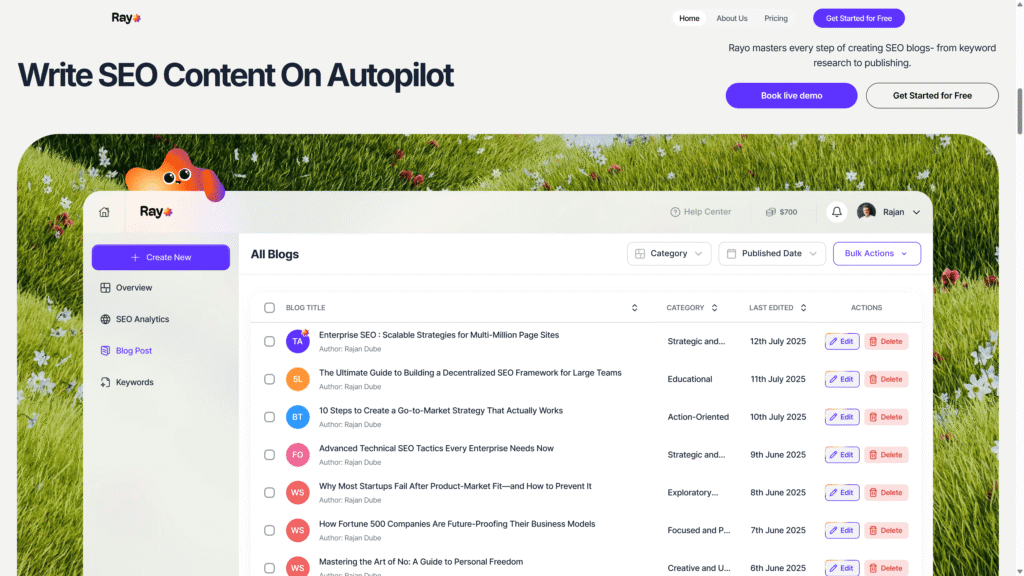AI writing tools have revolutionized content creation, and while Writesonic has been a popular choice, many users are seeking alternatives that better suit their specific needs. Whether you’re looking for different features, pricing models, or specialized capabilities, there’s no shortage of options in 2025. Let’s dive into the top Writesonic alternatives and how they stack up against each other.
Top Writesonic Alternatives in 2025
Jasper AI vs Writesonic: Which writes better?
Jasper AI produces more natural-sounding content compared to Writesonic. Its Boss Mode creates a smooth, real-time collaboration with AI that feels intuitive. While Writesonic relies heavily on templates, Jasper shines with free-flowing, creative content. This quality gap becomes especially noticeable in longer articles where Jasper’s contextual understanding gives it the edge.
Rayo: SEO Content on Autopilot
Rayo differentiates itself with laser-focused SEO content creation. Unlike Writesonic’s more general approach, Rayo builds keyword research directly into the writing process. Its automation extends beyond basic text generation to include SERP analysis and competitive research. Content marketers focused on organic traffic will appreciate Rayo’s streamlined workflow compared to Writesonic’s multi-step approach.

Copy.ai: Better long-form or just short form?
Copy.ai has always excelled at short-form content but has significantly upped its long-form game. While Writesonic offers more structured templates for articles, Copy.ai gives you greater creative freedom. It still dominates in crafting catchy headlines and persuasive sales copy, but now gives Writesonic serious competition in blog creation too.
Sudowrite: Ideal for writers or marketers?
Sudowrite caters to creative writers rather than marketers. Its “Show, Don’t Tell” and “Describe” features help fiction writers create vivid scenes, contrasting with Writesonic’s commercial content focus. For creative projects, Sudowrite provides more nuanced assistance, but marketers seeking conversion-focused copy will still prefer Writesonic.
Anyword: Is its predictive scoring worth the cost?
Anyword’s standout feature is its predictive performance scoring that estimates conversion rates for different copy variations. This data-driven approach helps marketers refine content before publishing. Though it costs more than Writesonic, Anyword’s analytics can deliver better ROI by removing guesswork from content performance.
Writesonic vs Rytr: Best AI copy on a budget?
Rytr wins as the budget champion, delivering similar capabilities to Writesonic at a lower price point. While Writesonic offers more templates and slightly higher quality output, Rytr provides exceptional value for small businesses. The quality difference has shrunk considerably, making Rytr compelling for cost-conscious users.
INK vs Writesonic: Who wins in AI-SEO focus?
INK combines AI writing with robust SEO tools more thoroughly than Writesonic. Its real-time SEO scoring helps writers hit search targets while drafting. Although Writesonic includes some SEO features, INK’s dedicated focus on search performance gives it the advantage for content creators who prioritize organic traffic.
Wordtune: Real competitor or just an editing plugin?
Wordtune works differently from Writesonic, functioning primarily as an AI editor rather than a content creator. It excels at rewriting and refining existing content, making it complementary to rather than competitive with Writesonic. For users who prefer drafting their own content but want AI help with polishing, Wordtune offers unique value.
Benchmarks to Compare Best AI Writing Tools
User experience and writing quality
The best AI writing tools balance intuitive interfaces with high-quality output. Look beyond flashy features to assess how tools handle nuance, maintain consistent tone, and avoid repetition. Testing outputs across different content types reveals each platform’s versatility and understanding of context.
Pricing and credits flexibility
AI writing tools use various pricing models from subscriptions to pay-per-use. Consider your content volume when choosing. Some tools offer unlimited generation within tiers, while others use credit systems. The right model depends on whether you need occasional high-quality pieces or regular content production.
SEO optimization tools and features
Top-tier AI writing tools should integrate seamlessly with SEO workflows. Compare how platforms handle keyword research, SERP analysis, and optimization suggestions. The best tools provide actionable insights without requiring users to switch between multiple platforms for research and writing.
Suitability across use-cases and teams
Versatility matters, especially for teams creating diverse content. Evaluate how tools perform across blogs, social media, emails, and product descriptions. Also consider collaboration features, access controls, and how easily the platform fits into your existing content workflow.
Real-time language learning and adaptation
Leading AI writing tools continuously improve through user feedback and new training data. Platforms that adapt to emerging language patterns, industry terminology, and changing search algorithms provide lasting value. Look for tools that regularly update their models and allow for user training.
Why Rayo is the best alternative to Writesonic for content writing?
Rayo stands out as the top Writesonic alternative for several compelling reasons. Its pay-per-use pricing model offers cost-effectiveness for businesses of all sizes, eliminating the need for expensive subscriptions. The platform integrates keyword research directly into the content creation workflow, saving valuable time and streamlining the process.
What truly sets Rayo apart is its combination of AI-powered writing that generates remarkably natural, human-like content with an SEO-focused structure. Each piece comes with optimized headings, strategic keyword placement, and enhanced readability scores. This balanced approach ensures content that appeals to both search engines and human readers.
Perhaps most impressive is Rayo’s end-to-end automation capabilities. The platform handles everything from initial topic ideation to final publishing in one unified system. This comprehensive approach eliminates the need to juggle multiple tools and platforms, making Rayo the ideal Writesonic alternative for efficiency-minded content creators in 2025.

Ridam Khare is an SEO strategist with 7+ years of experience specializing in AI-driven content creation. He helps businesses scale high-quality blogs that rank, engage, and convert.



